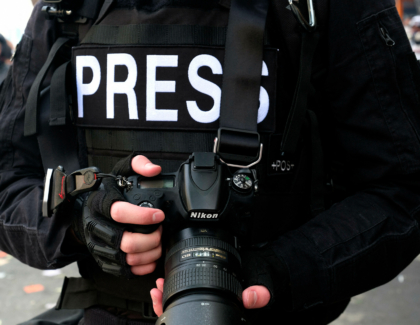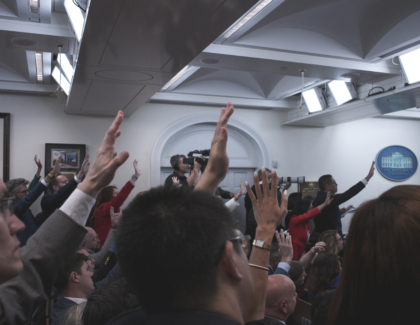Sign up for the daily CJR newsletter.
This weekend, global leaders of the seven wealthy democratic nations known as the G-7—the US, Canada, France, Germany, Italy, Japan, and the UK—met for their annual summit, along with leaders from Australia, India, South Korea, and South Africa. Those who spent the past year heralding the transformation effect the pandemic might catalyze across the world may find themselves disappointed; much of the coverage emphasized a return to convention, with some modest markers of change. Pew surveys showed that, under the Biden presidency, public opinion has rebounded significantly in at least a dozen countries, including all of the six other countries included in the G-7; CNN reported “sighs of relief.” The US is “back at the table,” Biden said, and the group recycled the Biden campaign slogan in their infrastructure aid program, calling it “Build Back Better for the World.” Three subjects rose to the top of summit coverage: the group’s pandemic response, commitments to climate action, and foreign policy toward China.
On Friday, the first day of the meetings, the group announced that it would donate one billion vaccine doses to other countries over the next year, a headline–grabbing move that vows to add 870 million new doses to those already promised or funded since last February’s summit. The International Monetary Fund and the World Health Organization both quickly responded to say the plan was not ambitious enough, the WHO suggesting that eleven billion doses would be necessary to end the pandemic. The United Nations echoed the sentiment, saying “we need more.”
On climate action, critics also noticed the group’s disproportionate power in the world and felt that its action failed to match its influence. Though the Times called the G-7 climate action “aggressive”, the BBC reported that the group “disappointed activists.” Reversing some of the US stonewalling on climate that marked the status quo of the Trump era, the Group of Seven promised to cut carbon emissions in half by 2030; they agreed on the need to end the use of coal, but did not choose a deadline by which to do so. Recently, Mark Hertsgaard at The Nation (and executive director of Covering Climate Now, the media collaborative co-founded with CJR) wrote that most media coverage has focused on such emissions cuts, though a Paris Agreement promise to provide $100 billion to under-resourced countries has not been fulfilled; the pledge, Hertsgaard wrote, is “equally important, though much less discussed,” despite “the truism that climate change is overwhelmingly caused by the rich but disproportionately punishes the poor.”
ICYMI: Why Can’t We Call it an Emergency?
The group’s foreign policy toward China was less unified in message, and coverage waffled between highlighting consensus—like the group’s collective condemnation of China’s human rights abuses in Xinjiang and anti-democratic action in Hong Kong—and emphasizing divisions—like many leaders’ hesitance to go as far as Biden had hoped. The Times wrote that “the session had distinctly Cold War overtones — a reflection of the deepening sense that a declining Russia and rising China are forming their own adversarial bloc to challenge the West,” adding that Biden’s foreign policy doctrine is framed in terms of “a struggle between dissonant, often unruly democracies and brutally efficient but repressive autocrats,” a framing that some newsrooms accepted—especially in pieces leading up to the summit. The president even submitted an Op-Ed to the Washington Post to promote his agenda, writing, “Will the democratic alliances and institutions that shaped so much of the last century prove their capacity against modern-day threats and adversaries? I believe the answer is yes.” For its part, China pushed back, saying through a spokesman at the London embassy, “The days when global decisions were dictated by a small group of countries are long gone.”
After more than a year of domestic news coverage on global events that clearly acknowledged the interconnectedness of the world, the press in G-7 countries—many of which now find their pandemic response on more solid footing than the rest of the world—will struggle to balance the traditional framing of foreign policy news coverage against one of the epiphanies of the last year: things that happen “over there” also matter here. Climate action cannot be limited to domestic policies, or it will fail, both globally and domestically. The global vaccination effort cannot be limited to a small group of nations, or it will fail, too. Reporting for one’s audience also requires situating such coverage in collective terms, because that’s the nature of the world. The past year has shown the value of globally-minded reporting, and as the world shifts again, that’s a value to maintain.
Below, more on summit coverage:
- The written record: For the AP, Ellen Knickmeyer detailed the flurry of work that interpreters, diplomats, and aides undergo to produce official memos amid presidential summits. In one-on-one meetings between world leaders, those in the room are responsible for keeping records of conversations that are eventually declassified. “Because it’s in the dark spaces, it’s in the unlit spaces of government activity that abuses occur, or can occur,” NYU professor Timothy Naftali told Knickmeyer.
- Protest, visualized: The Guardian published a photo essay documenting the protesters that gathered in response to the Cornwall summit in support of various causes: Pro-Palestine activists marched on Downing Street—which houses the offices and residence of the British Prime Minister—while surfers and paddle boarders took to the water to protest environmental degradation.
Other notable stories:
- Dow Jones, owner and publisher of The Wall Street Journal, announced a new policy on Friday that restricts and asserts control over book deals and other external projects for WSJ reporters. Journalists need permission from the editor-in-chief before talking to publishers or agents, and they can’t use their reporting in published books without first licensing it from Dow Jones, Axios’ Felix Salmon reported.
- In other media labor news, about 100 New York Times reporters signed a letter in favor of a media union dues increase, countering last week’s letter in which a number of high-profile reporters wrote a letter in opposition, Hamilton Nolan reported. And Ben Smith covered the divisions within the unionization effort at The New Yorker and disclosed that writers at the magazine referred to David Remnick as “Dad.”
- Last week, the US Park police issued a report that seemed to suggest that police gassing peaceful protestors in Lafayette Park last June was not a result of then-president Trump seeking a photo op at a nearby church; many criticized media coverage for getting the story wrong. But such criticism was overly credulous and harsh, Ryan Cooper argued for The Week. The report is incomplete, Cooper wrote, and bears more reporting; furthermore, outlets were reporting on what they knew at the time. “Whether the park clearance was initially planned as a cynical political stunt, Trump instantly turned it into one,” he wrote. “His callous, incompetent style of government ensured the clearance would be done with maximum brutality.”
- The Pulitzer Prizes were awarded on Friday. In a special citation, the board awarded an honorary prize to Darnella Frazier, who was seventeen when she recorded video footage of George Floyd’s murder on her cell phone. The video sparked a global movement against racism and police violence and played a central role in the conviction of Officer Derek Chauvin for Floyd’s murder.
- Kristen Hare noted for Poynter that California Sunday magazine, which won a Pulitzer Prize on Friday for Nadja Drost’s feature on asylum seekers attempting to cross into the United States, was one of more than seventy-five newsrooms that shut down during the pandemic. (To explore a map and table detailing newsroom cutbacks amid the pandemic, see the Tow Center’s cutback tracker, a joint project with CJR).
- For Politico, Jack Shafer wrote that the local news crisis is driven, in part, by waning demand. Local news outlets have disappeared; so have readers. “It’s not that nobody wants to read local news; it’s just that not enough people do to make it a viable business,” Shafer wrote. “But even if you were to underwrite local news with taxes and philanthropy, and distribute it to citizens via subsidies, you’d still have to find a way to get people to read it.”
ICYMI: What the ephemerality of the Web means for your hyperlinks
Has America ever needed a media defender more than now? Help us by joining CJR today.







